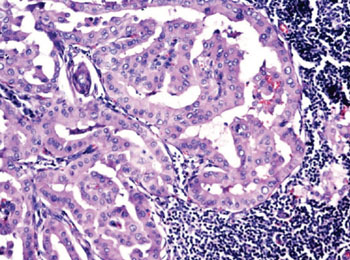Gene Fusion Identified as Cause of Rare Thyroid Cancer
By LabMedica International staff writers
Posted on 03 Apr 2014
Analysis of tumor and whole blood DNA by whole genome sequencing has identified the fusion of two genes as the genetic driver in an aggressive tall cell variant of papillary thyroid cancer. Posted on 03 Apr 2014
Recent advances in the treatment of cancer have focused on targeting genomic aberrations with selective therapeutic agents, but in radioiodine resistant aggressive papillary thyroid cancers, there remain few effective therapeutic options.

Image: Photomicrograph of tall cell variant of papillary thyroid carcinoma metastases in the axillary lymph nodes (Photo courtesy of Dr. Arvind Krishnamurthy).
Scientists at the Translational Genomics Research Institute (Phoenix, AZ, USA) obtained a blood and tumor sample from the patient, a 62-year-old man who underwent multiple operations for papillary thyroid cancer and whose metastases progressed despite standard treatments. Whole genome sequencing of tumor and white blood cell DNA was conducted by a commercial vendor according to their methods using photolithographically patterned high-density nanoarrays onto which palindrome-promoted coils of single-stranded DNA are absorbed (Complete Genomics; Mountain View, CA, USA).
Tumor paraffin blocks were submitted to ARUP Laboratories (Salt Lake City, UT, USA) for validation by reverse transcriptase polymerase chain reaction (RT-PCR) in a Clinical Laboratory Improvement Amendments (CLIA) certified laboratory. A comparison of the tumor DNA to the patient's normal DNA found 57 mutations in 55 genes of the cancer genome. The investigators also found a rearrangement between two genes. This translocation and fusion of the echinoderm microtubule associated protein like 4 (EML4) gene and the anaplastic lymphoma receptor tyrosine kinase (ALK) gene, was identified as the genetic driver of the patient's cancer.
Michael J. Demeure, MD, the study's principal investigator and lead author, said, “This is the first report of the whole genome sequencing of a papillary thyroid cancer, in which we identified an EML4-ALK translocation. This is important because we have a drug that can target this fusion and treat the patient. This patient's tumor did not harbor more well-known gene mutations that are associated with most thyroid cancers. These findings suggest that this tumor has a distinct oncogenesis, or the genetic cause of cancer.” The study was published on March 15, 2014, in the World Journal of Surgery.
Related Links:
Translational Genomics Research Institute
Complete Genomics
ARUP Laboratories













